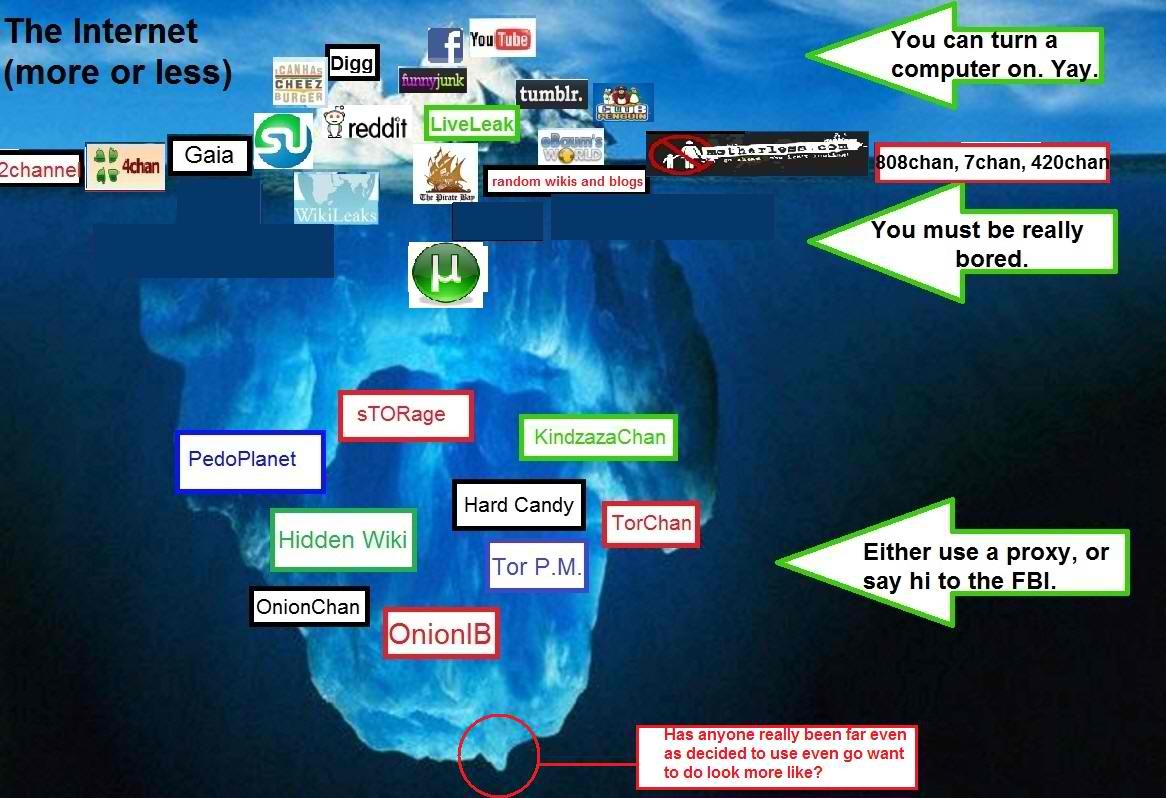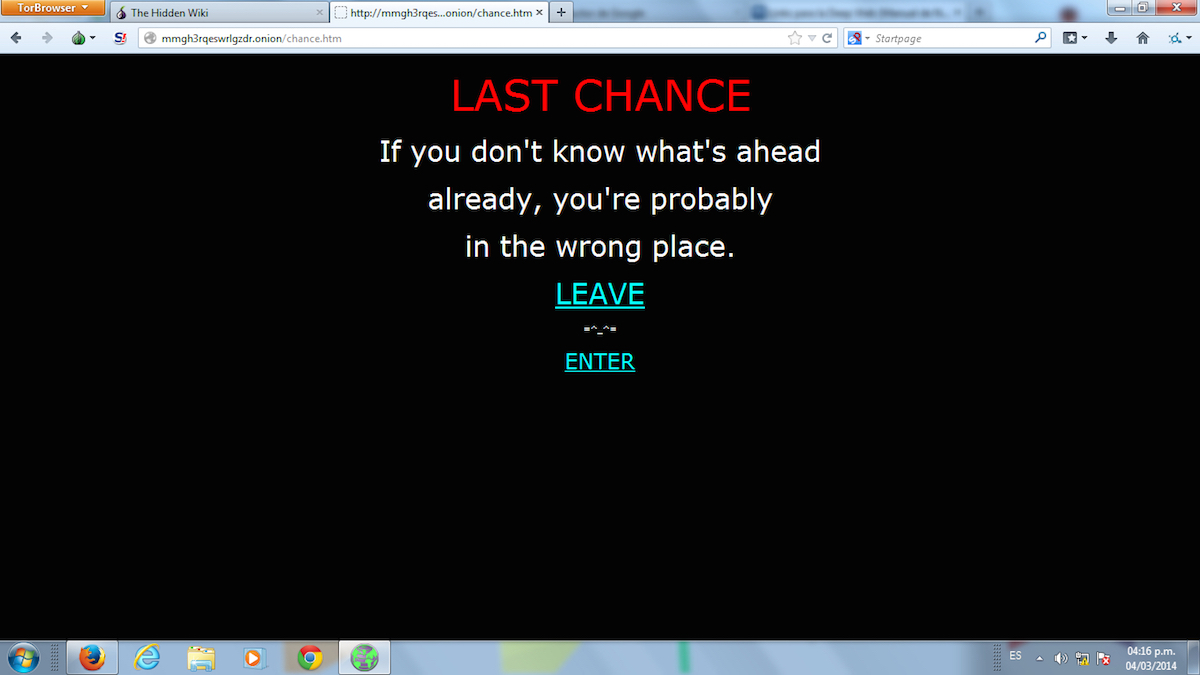The Dark Web
Reddit: the front page of the internet. Things you need to do before you access the deep web: Tor.. Question that is hard to find the answer to on google.


There’s a part of the internet known as the deep web. The deep web is called the deep web because of its massive size, it’s literally ‘deep’. According to The Guardian, you can only access 0.03% of the internet via search engines like Google and the rest is what makes up the deep web. The deep web is truly anonymous – you can’t even get on it unless you yourself are anonymous. Here we go. Hit NEXT to start your journey.
Deep Web (also called the Deepnet, Invisible Web, or Hidden Web) is the portion of World Wide Web content that is not indexed by standard search engines.

Feb 4, 2015.. The Dark Web is supposed to be the Internet's seedy back alley. But the real Dark Web is a lot more complicated than that. From TOR to the Silk ..

Deep Web (also called the Deepnet, Invisible Web, or Hidden Web) is the portion of World Wide Web content that is not indexed by standard search engines. Mike Bergman, founder of BrightPlanet and credited with coining the name, said that searching on the internet today can be compared to dragging a net across the surface of the ocean: a great deal may be caught in the net, but there is a wealth of information that is deep and therefore missed. Most of the web's information is buried far down on sites, and standard search engines do not find it. Traditional search engines cannot see nor retrieve content in the deep web. The portion of the web that is indexed by standard search engines is known as the surface web. As of 2001[the deep web was several orders of magnitude larger than the surface web. The deep web is a separate entity from the dark internet, which is made up of computers that can no longer be reached via the internet. Also, the Darknet—ambiguously known as Dark Web—which consists of various anonymizing networks like Tor and the resources that they provide access to, is not synonymous with the deep web, but is a subsection of it. Although much of the deep web is innocuous, some prosecutors and government agencies, among others, are concerned that the deep web is a haven for serious criminality. Bright Planet, a web-services company, describes the size of the deep web in this way: It is impossible to measure, and hard to put estimates on, the size of the deep web because the majority of the information is hidden or locked inside databases. Early estimates suggested that the deep web is 400 to 550 times larger than the surface web. However, since more information and sites are always being added, it can be assumed that the deep web is growing exponentially at a rate that cannot be quantified. Estimates based on extrapolations from a study done at University of California, Berkeley in 2001 speculate that the deep web consists of about 7.5 petabytes. More accurate estimates are available for the number of resources in the deep web: research of He et al. detected around 300,000 deep web sites in the entire web in 2004, and, according to Shestakov, around 14,000 deep web sites existed in the Russian part of the Web in 2006. Bergman, in a seminal paper on the deep Web published in The Journal of Electronic Publishing, mentioned that Jill Ellsworth used the term invisible Web in 1994 to refer to websites that were not registered with any search engine. Bergman cited a January 1996 article by Frank Garcia: It would be a site that's possibly reasonably designed, but they didn't bother to register it with any of the search engines. So, no one can find them! You're hidden. I call that the invisible Web. Another early use of the term Invisible Web was by Bruce Mount and Matthew B. Koll of Personal Library Software, in a description of the @1 deep Web tool found in a December 1996 press release. The first use of the specific term Deep Web, now generally accepted, occurred in the aforementioned 2001 Bergman study. Methods which prevent web pages from being indexed by traditional search engines may be categorized as one or more of the following: Dynamic content: dynamic pages which are returned in response to a submitted query or accessed only through a form, especially if open-domain input elements (such as text fields) are used; such fields are hard to navigate without domain knowledge. Unlinked content: pages which are not linked to by other pages, which may prevent web crawling programs from accessing the content. This content is referred to as pages without backlinks (also known as inlinks). Also, search engines do not always detect all backlinks from searched web pages. Private Web: sites that require registration and login (password-protected resources). Contextual Web: pages with content varying for different access contexts (e.g., ranges of client IP addresses or previous navigation sequence). Limited access content: sites that limit access to their pages in a technical way (e.g., using the Robots Exclusion Standard or CAPTCHAs, or no-store directive which prohibit search engines from browsing them and creating cached copies.) Scripted content: pages that are only accessible through links produced by JavaScript as well as content dynamically downloaded from Web servers via Flash or Ajax solutions. Non-HTML/text content: textual content encoded in multimedia (image or video) files or specific file formats not handled by search engines. Software: Certain content is intentionally hidden from the regular internet, accessible only with special software, such as Tor, I2P, or other darknet software. For example, Tor allows users to access websites using the .onion host suffix anonymously, hiding their IP address. While it is not always possible to directly discover a specific web server's content so that it may be indexed, a site potentially can be accessed indirectly (due to computer vulnerabilities). To discover content on the web, search engines use web crawlers that follow hyperlinks through known protocol virtual port numbers. This technique is ideal for discovering content on the surface web but is often ineffective at finding deep web content. For example, these crawlers do not attempt to find dynamic pages that are the result of database queries due to the indeterminate number of queries that are possible. It has been noted that this can be (partially) overcome by providing links to query results, but this could unintentionally inflate the popularity for a member of the deep web. DeepPeep, Intute, Deep Web Technologies, Scirus, and Ahmia.fi are a few search engines that have accessed the deep web. Intute ran out of funding and is now a temporary static archive as of July, 2011. Scirus retired near the end of January, 2013. Researchers have been exploring how the deep web can be crawled in an automatic fashion, including content that can be accessed only by special software such as Tor. In 2001, Sriram Raghavan and Hector Garcia-Molina (Stanford Computer Science Department, Stanford University) presented an architectural model for a hidden-Web crawler that used key terms provided by users or collected from the query interfaces to query a Web form and crawl the Deep Web content. Alexandros Ntoulas, Petros Zerfos, and Junghoo Cho of UCLA created a hidden-Web crawler that automatically generated meaningful queries to issue against search forms. Several form query languages (e.g., DEQUEL) have been proposed that, besides issuing a query, also allow extraction of structured data from result pages. Another effort is DeepPeep, a project of the University of Utah sponsored by the National Science Foundation, which gathered hidden-web sources (web forms) in different domains based on novel focused crawler techniques. Commercial search engines have begun exploring alternative methods to crawl the deep web. The Sitemap Protocol (first developed, and introduced by Google in 2005) and mod oai are mechanisms that allow search engines and other interested parties to discover deep web resources on particular web servers. Both mechanisms allow web servers to advertise the URLs that are accessible on them, thereby allowing automatic discovery of resources that are not directly linked to the surface web. Google's deep web surfacing system computes submissions for each HTML form and adds the resulting HTML pages into the Google search engine index. The surfaced results account for a thousand queries per second to deep web content. In this system, the pre-computation of submissions is done using three algorithms: selecting input values for text search inputs that accept keywords, identifying inputs which accept only values of a specific type (e.g., date), and selecting a small number of input combinations that generate URLs suitable for inclusion into the Web search index. In 2008, to facilitate users of Tor hidden services in their access and search of a hidden .onion suffix, Aaron Swartz designed Tor2web—a proxy application able to provide access by means of common web browsers. Using this application, deep web links appear as a random string of letters followed by the .onion TLD. For example, http://xmh57jrzrnw6insl.onion links to TORCH, the Tor search engine web page. Most of the work of classifying search results has been in categorizing the surface web by topic. For classification of deep web resources, Ipeirotis et al. presented an algorithm that classifies a deep web site into the category that generates the largest number of hits for some carefully selected, topically-focused queries. Deep web directories under development include OAIster at the University of Michigan, Intute at the University of Manchester, Infomine at the University of California, Riverside, and DirectSearch (by Gary Price). This classification poses a challenge while searching the deep web whereby two levels of categorization are required. The first level is to categorize sites into vertical topics (e.g., health, travel, automobiles) and sub-topics according to the nature of the content underlying their databases. The more difficult challenge is to categorize and map the information extracted from multiple deep web sources according to end-user needs. Deep web search reports cannot display URLs like traditional search reports. End users expect their search tools to not only find what they are looking for, but to be intuitive and user-friendly. In order to be meaningful, the search reports have to offer some depth to the nature of content that underlie the sources or else the end-user will be lost in the sea of URLs that do not indicate what content lies beneath them. The format in which search results are to be presented varies widely by the particular topic of the search and the type of content being exposed. The challenge is to find and map similar data elements from multiple disparate sources so that search results may be exposed in a unified format on the search report irrespective of their source. Dark Internet Darknet (overlay network) I2P Tor Tor2web Gopher protocol The Hidden Wiki Shestakov, Denis (June 2008). Search Interfaces on the Web: Querying and Characterizing. TUCS Doctoral Dissertations 104, University of Turku
There's a part of the internet known as the deep web. The deep web is called the deep web because of its massive size, it's literally 'deep'. According to The ..

How to Search the Deep Web. Search engines such as Google index well over a trillion pages on the World Wide ..
Below the easily-searchable surface Web is more information than you can imagine. Find out what's going on in the deep Web.
Inside the Dark Web turns to the topic of internet surveillance concerning the pros and cons of the ability for everything that passes over the immense..
Nov 19, 2014.. With the rise and fall of the Silk Road—and then its rise again and fall again—the last couple of years have cast new light on the Dark Web.

Deep Web